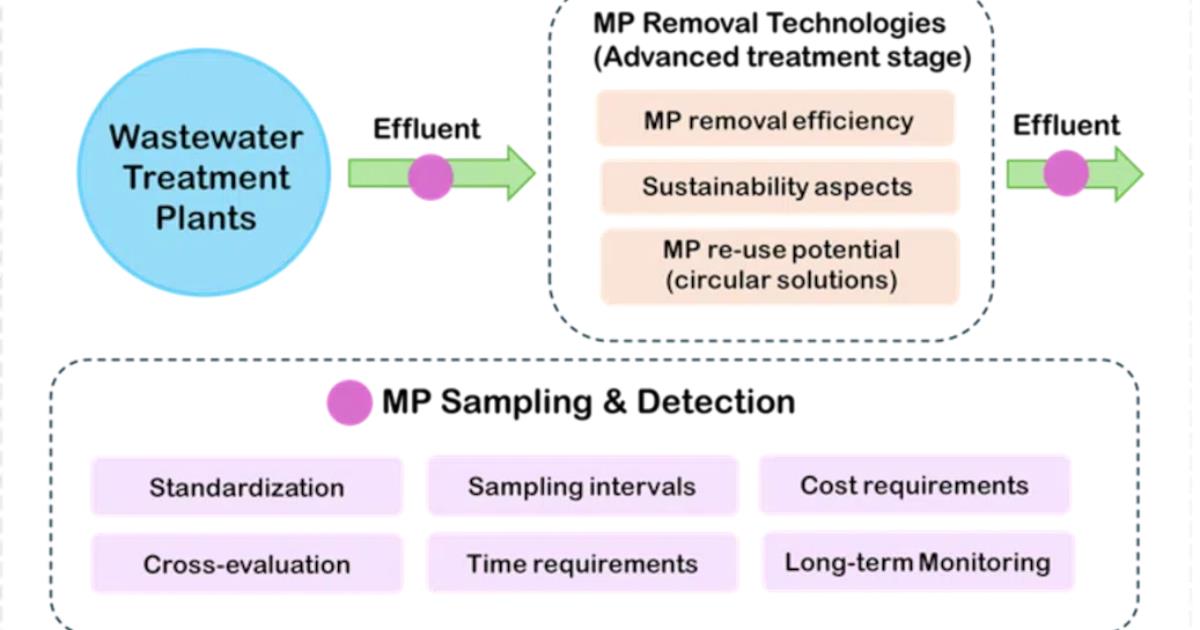- 3.0Impact Factor
- 6.0CiteScore
- 20 daysTime to First Decision
Microplastic Removal and Assessment in Wastewater Treatment Plants
This special issue belongs to the section “Wastewater Treatment and Reuse“.
Special Issue Information
Dear Colleagues,
Wastewater treatment plants (WWTPs) have been identified as important point sources for microplastics (MPs) in the environment. Most modern WWTPs are equipped with three treatment stages and must adhere to the EU Urban Wastewater Treatment Directive (Council Directive 91/271/EEC) (UWWTD). However, it has been found that although such WWTPs can remove between 64 and >99% of MPs from wastewater, depending on their design and operating conditions, due to the high volumes of treated wastewater, significant amounts of MPs are still discharged into the environment. The revised UWWTD includes mandatory sampling and analysis of MP levels at least twice a year for WWTPs with >100,000 population equivalents (PEs) and once every 2 years for WWTPs with >10,000 PEs. However, the results of long-term monitoring studies indicate that MP contamination levels have high fluctuations, and a much higher frequency of sampling is required to obtain representative results on MP levels.
MP monitoring consists of sampling, sample preparation, and the detection method. For each of these steps, there are still no standardized methods. Additionally, more regular monitoring is necessary to understand the hotspots of MP pollution and how contamination levels vary according to different treatment processes, as well as to obtain reliable data to help implement effective legislation.
This Special Issue, therefore, aims to focus on the following topics:
- Data collection with various MP detection methods;
- New analytical devices and innovative methods for quick, easy, and reliable MP detection;
- Analysis of MP removal efficiencies at WWTPs with and without targeted MP removal technologies;
- Comparison of removal technologies;
- Long-term MP monitoring;
- All aspects of sustainability and impact measurements, including sustainable process design and lifecycle analysis, as well as new circular solutions (with a focus on MPs and water reuse).
Dr. Katrin Schuhen
Dr. Uroš Novak
Guest Editors
Manuscript Submission Information
Manuscripts should be submitted online at www.mdpi.com by registering and logging in to this website. Once you are registered, click here to go to the submission form. Manuscripts can be submitted until the deadline. All submissions that pass pre-check are peer-reviewed. Accepted papers will be published continuously in the journal (as soon as accepted) and will be listed together on the special issue website. Research articles, review articles as well as short communications are invited. For planned papers, a title and short abstract (about 250 words) can be sent to the Editorial Office for assessment.
Submitted manuscripts should not have been published previously, nor be under consideration for publication elsewhere (except conference proceedings papers). All manuscripts are thoroughly refereed through a single-blind peer-review process. A guide for authors and other relevant information for submission of manuscripts is available on the Instructions for Authors page. Water is an international peer-reviewed open access semimonthly journal published by MDPI.
Please visit the Instructions for Authors page before submitting a manuscript. The Article Processing Charge (APC) for publication in this open access journal is 2600 CHF (Swiss Francs). Submitted papers should be well formatted and use good English. Authors may use MDPI's English editing service prior to publication or during author revisions.
Keywords
- microplastics
- wastewater
- wastewater treatment plant
- cleaning stages
- microplastics removal technology
- pollution
- environmental protection

Benefits of Publishing in a Special Issue
- Ease of navigation: Grouping papers by topic helps scholars navigate broad scope journals more efficiently.
- Greater discoverability: Special Issues support the reach and impact of scientific research. Articles in Special Issues are more discoverable and cited more frequently.
- Expansion of research network: Special Issues facilitate connections among authors, fostering scientific collaborations.
- External promotion: Articles in Special Issues are often promoted through the journal's social media, increasing their visibility.
- e-Book format: Special Issues with more than 10 articles can be published as dedicated e-books, ensuring wide and rapid dissemination.

